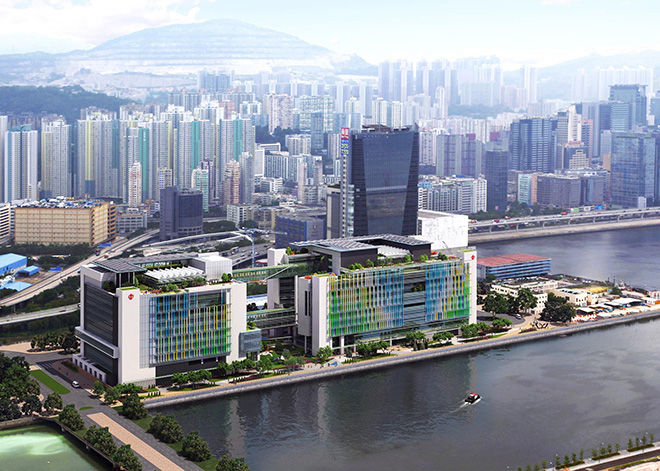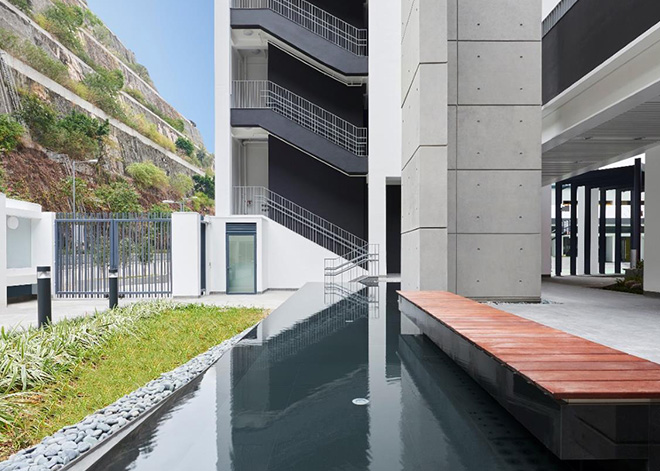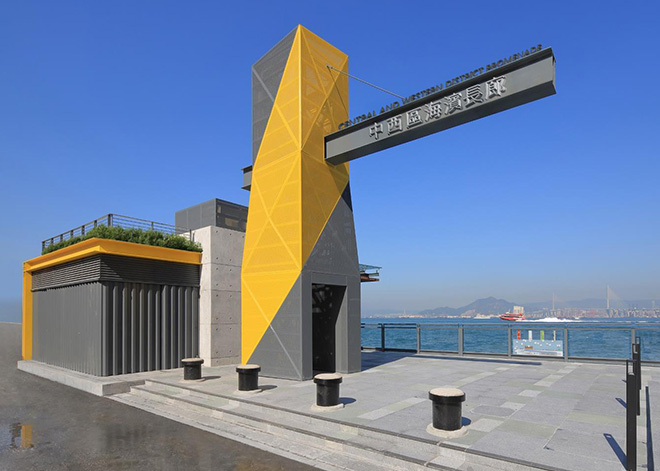Environmental Performance
Resources Usage - Energy
| Units | 2017 | 2016 | 2015 | 2014 | 2013 | |
|---|---|---|---|---|---|---|
| Electricity consumed (QGO and APB Centre) [1] | kWh/m2 | 200 | 208 | 217 | 219 | 218 |
| CO2 emission equivalent to electricity consumption (QGO and APB Centre) [2] | Tonnes CO2-e | 3,553 | 3,664 | 3,840 | 3,817 | 3,808 |
| Energy saved due to energy efficient installations [3] | GWh | 4.44 | 5.74 | 5.16 | 0.79 [4] | 6.90 |
| Equivalent monetary savings [5] | HK$ million | 5.33 | 6.89 | 6.19 | 0.95 [4] | 6.90 |
| Avoided CO2 emissions [3] | Kilo Tonnes CO2-e | 3.11 | 4.02 | 3.61 | 0.55 [4] | 4.83 |
| [1] | Offices in QGO and APB Centre represent a majority of total ArchSD office space. Total ArchSD office area is assumed to be 25,386.2 m2 (11,275.4 m2 for APB and 14,110.8 m2 for QGO 31/F& 33/F-41/F). The percentage of electricity consumption of the whole premises for ArchSD office at APB & QGO is assumed to be 100% and 20% respectively. |
|---|---|
| [2] | Territory wide default GHG emission factors (0.7) were used based on the Guidelines to Account for and Report on Greenhouse Gas Emissions and Removals for buildings (Commercial, Residential or Institutional Purpose) in Hong Kong issued by the Environmental Protection Department, HKSAR in February 2010. |
| [3] | Energy efficient features refer to energy saving installation for air-conditioning systems, lighting systems, hot water systems, lift & escalator systems, building energy management system and renewable energy technologies. |
| [4] | The nature of the completed projects (i.e. parks, open spaces, promenade, aqua privies, radar station, etc.) in 2014 did not warrant significant energy saving in term of BS installations. |
| [5] | The electricity tariff is assumed to be HK$ 1.2 per kWh and HK$ 1.0 per kWh from 2014 onward and before 2014 respectively. |
Resource Usage - Fuel
| Units | 2017 | 2016 | 2015 | 2014 | 2013 | |
|---|---|---|---|---|---|---|
| Fuel consumption by ArchSD's pool cars | Litre | 12,626 | 12,656 | 13,071 | 12,800 | 13,142 |
| GHG emission equivalent to fuel consumption by ArchSD pool cars [6] | Tonnes CO2-e | 34.2 | 34.3 | 35.4 | 34.7 | 35.6 |
| [6] | GHG emission factors for mobile combustion are based on the Guidelines to Account for and Report on Greenhouse Gas Emissions and Removals for buildings (Commercial, Residential or Institutional Purpose) in Hong Kong issued by the Environmental Protection Department, HKSAR in February 2010. |
|---|
Resource Usage - Office Materials
| Units | 2017 | 2016 | 2015 | 2014 | 2013 | |
|---|---|---|---|---|---|---|
| A4 paper consumption | Reams | 16,947 | 18,082 | 18,169 | 18,485 | 18,346 |
| A3 paper consumption | Reams | 1,020 | 1,169 | 1,171 | 1,118 | 1,053 |
| Envelop consumption | No. | 37,615 | 35,672 | 42,883 | 44,084 | 43,294 |
Waste Management in Programme Areas of Facilities Development and Upkeeping
| Units | 2017 | 2016 | 2015 | 2014 | 2013 | |
|---|---|---|---|---|---|---|
| Construction & demolition materials | ||||||
| C&D waste disposed of to landfills | Tonnes | 44,891 | 36,775 | 46,822 | 37,593 | 24,125 |
| C&D materials disposed of to public fill areas | Tonnes | 518,946 | 543,054 | 693,029 | 604,238 | 644,728 |
| Recyclable waste collected at APB Centre | ||||||
| Waste paper | kg | 15,579 | 15,717 | 15,932 | 19,522 | 19,335 |
| Aluminium | No. | 2,050 | 1,676 | 1,631 | 4,918 | 5,900 |
| Plastic bottles | No. | 4,102 | 3,798 | 3,013 | 2,975 | 3,385 |
Environmental Convictions of Contractors
| Units | 2017 | 2016 | 2015 | 2014 | 2013 | |
|---|---|---|---|---|---|---|
| Convictions per 100,000 man-hours | ArchSD's sites (All construction sites in HK) |
0.034 (0.216) |
0.122 (0.191) |
0 [7] (0.25) |
0.35 (0.275) |
0.15 (0.618) |
| Monetary value of significant fines | HK$ | 5,000 | 100,000 | 0 [7] | 227,000 | 18,500 |
| [7] | In 2015, most of the on-site projects were in the final stages of the construction, hence environmental impacts to the neighbourhood were manageable and contented. |
|---|
Environmental Expenditure
| Units | 2017 | 2016 | 2015 | 2014 | 2013 | |
|---|---|---|---|---|---|---|
| Resources devoted to environmental works [8] | HK$ million | 1,101.3 | 568.4 | 639.3 | 761.6 | 892.2 |
| Percentage of annual expenditure | % | 9.7 | 6.3 | 7.3 | 10.9 | 12.2 |
| [8] | Resources devoted to environmental works included the expenditures on environmental nature projects and associated personal emoluments and departmental charges, staff’s environmental training and works on maintaining environmental management system. |
|---|
Social Performance [9]
Staff
| Units | 2017 | 2016 | 2015 | 2014 | 2013 | |
|---|---|---|---|---|---|---|
| Staff establishment (As at 31 December) | No. | 1,859 | 1,835 | 1,814 | 1,810 | 1,795 |
| [9] | Staff data is extracted from the records kept in the personnel section. |
|---|
Staff Breakdown
| By Post (based on staff establishment) | ||
|---|---|---|
| Directorate | % | 2 |
| Professional | % | 25 |
| General Staff | % | 20 |
| Site Staff | % | 31 |
| Technical | % | 22 |
| By Employment Type | ||
| Full-time | % | 100 |
| By Employment Contract | ||
| Permanent (male) | % | 63 |
| Permanent (female) | % | 31 |
| Contract (male) | % | 4 |
| Contract (female) | % | 2 |
| By Age (31.3.2018) | ||
| Age under 30 | % | 12 |
| Age 30-49 | % | 46 |
| Age 50 or above | % | 42 |
| By Ethnicity | ||
| Local | % | 100 |
| Non-local | % | 0 |
| By Gender | ||
| Male | % | 67 |
| Female | % | 33 |
Staff Training
| Units | 2017 | 2016 | 2015 | 2014 | 2013 | |
|---|---|---|---|---|---|---|
| No. of training courses (including internal and external seminars/ workshops/ training courses/ visits) | No. | 412 | 366 | 374 | 287 | 270 |
| Numbers of trainees | No. | 7,488 | 8,302 | 6,961 | 6,619 | 6,674 |
Training Hours Breakdown [10]
| Type of Staff | Total Training Hours Received (hours) | Training Hours Per Staff (hours) |
|---|---|---|
| Directorate Staff | 1,343 | 36 |
| Professional Grade Staff | 17,204 | 37 |
| Technical, Site Supervisory and General Grade Staff | 17,501 | 13 |
| Total | 36,048 | 20 |
| [10] | As there is no distinct requirement regarding receiving training in terms of gender, we do not report the data broken down by gender. |
|---|
Anti-corruption Training
| Type of Staff | Number of Staff Participated Anti-corruption Training | Percentage of Staff against establishment |
|---|---|---|
| Directorate Staff | 3 | 8.1% |
| Professional Grade Staff | 129 | 27.7% |
| Technical, Site Supervisory and General Grade Staff | 293 | 21.6% |
Staff Turnover
| Male | Female | |
|---|---|---|
| Age under 30 | 0.3% (6) | 0.1% (1) |
| Age 30-50 | 1% (19) | 0.1% (1) |
| Age 51-55 | 0.2% (4) | 0.1% (1) |
| Age 56-60 | 3.5% (65) | 0.7% (12) |
New Employee Hires
| Male | Female | |
|---|---|---|
| Age under 30 | 2.8% (51) | 1.1% (20) |
| Age 30-50 | 2.7% (50) | 1.2% (22) |
| Age 51-55 | 0.1% (1) | 0% (0) |
| Age 56-60 | 0% (0) | 0% (0) |
Staff Injury
| Units | 2017 | 2016 | 2015 | 2014 | 2013 | |
|---|---|---|---|---|---|---|
| Staff injury cases [11] | No. | 2 (Male:1, Female: 1) |
5 (Male: 4, Female: 1) |
4 | 4 | 1 |
| Staff sick leave granted for staff injury cases | Days | 14.5 | 168.5 | 50 | 174 | 7 |
| [11] | The definition of staff injury cases is the reported cases of occupational injuries, under Employee's Compensation Ordinance, resulting in death or incapacity for work over 3 days. |
|---|
Contractor's Accident Rate
| Units | 2017 | 2016 | 2015 | 2014 | 2013 | |
|---|---|---|---|---|---|---|
| No. of fatalities [12] (ArchSD) | No. | 1 (Male:1, Female:0) |
2 (Male:2, Female:0) |
0 | 1 (Male:1, Female:0) |
0 |
| Fatal accident rate [12] (ArchSD) | per 100,000 man-hours | 0.003 | 0.007 | 0 | 0.004 | 0 |
| Fatal accident rate [13] (HK Construction Industry) | per 100,000 man-hours | 0.005 | 0.003 | 0.006 | 0.007 | 0.008 |
| No. of non-fatal accidents (ArchSD) [12] | No. | 94 (Male: 88, Female: 6) |
70 (Male: 64, Female: 6) |
98 | 80 | 68 |
| Non-fatal accident rate [12] (ArchSD) | per 100,000 man-hours | 0.28 | 0.26 | 0.34 | 0.30 | 0.27 |
| Non-fatal accident rate [13] (HK Construction Industry) | per 100,000 man-hours | 0.91 | 0.96 | 1.08 | 1.16 | 1.13 |
102-48
| [12] | Data of 2017 and the previous years was extracted from PWP Construction Site Safety and Environmental Statistics System (PCSES) of DEVB as at 31 July 2018. |
|---|---|
| [13] | The accident rate of the HK Construction Industry is based on the published statistics of the Labour Department and using a conversion of 1.67 accidents per 100,000 man-hours equivalent to 60 accidents per 1,000 workers per year. |










